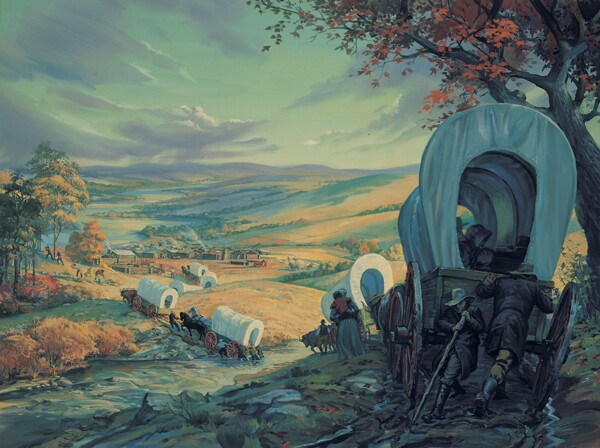The Oregon Trail—fording a river at the age of 10, hunting buffalo to extinction, falling prey to one of five specific diseases, and something “only 90s kids will remember.” Far more than just a remembrance of America’s early pioneers, The Oregon Trail is a computer game that was released by the Minnesota Educational Computer Consortium in 1974. Surprisingly, the game had a far wider reach than one generation. In fact, The Oregon Trail is one of the best-known and best-loved video games of all time. Over 10 years, the game sold over 65 million copies, and in 2016, it was inducted into the World Video Game Hall of Fame.
As an educational tool, The Oregon Trail teaches students about the westward journey of pioneers in a lighthearted way. Due to the game’s limitations, however, it leaves a great deal out. Read on to discover three Oregon Trail facts you didn’t learn while playing the video game.
1. Pioneer Companies Usually Consisted of More than One Family

The Oregon Trail puts you in charge of a family of five and then sends you off to survive the frontier alone. This situation of a single pioneer family would have been rare, with the exception of eventual homesteaders, who still lived in a relative proximity of growing number of neighboring homesteaders. Realizing the many dangers of crossing the plains, most pioneers elected to travel together.
Travelers leaving from Independence, Missouri, on the actual Oregon Trail were typically organized into caravans called “companies” or “wagon trains.” These groups could be over a hundred wagons long, although most of the time they consisted of 20 to 40 wagons, a number that was far more manageable.
2. Fording Rivers Was Tricky on the Oregon Trail
Players of The Oregon Trail will remember that encountering a river was risky. Paying for the ferry was expensive—but trying to ford it yourself could result in the loss of valuable supplies or party members. Still, most players agonized over the choice for less than a minute.
While fording rivers in The Oregon Trail game is a quick decision, that wasn’t the case for the pioneers. They faced the same challenge: pay the toll for a ferry or find another way across—and maybe lose your life, your livelihood, or your family in the process. Pioneers who attempted to cross rivers on their own spent a great deal of time planning and preparing.

To cross, some pioneers would caulk their wagons, dismantle them, and use the wagon box as a makeshift boat. Caulking and self-ferrying was not preferred, as it was slow and arduous. Others would lash felled trees together to make a raft, although this was one of the most dangerous options a family could take. These attempts at fording rivers cost the lives of many pioneers and their livestock.
3. From Horses to Pioneer Handcarts

Players starting their journey in The Oregon Trail know how important it is to purchase multiple yokes of oxen. This importance, on its own, is accurate; oxen were the favored animals for the journey west. They were hardy and strong and could graze along the trail. However, not everyone had a wagon with teams of oxen. As more travelers flocked westward, the demand for pioneer provisions increased; in some cases, oxen became scarce.
Many groups substituted horses, mules, or even cows for the required wagon teams. Pioneers that came from poorer backgrounds, however, could not afford the required animals or wagons. These pioneers used lighter, cheaper handcarts instead of covered wagons. While handcarts were cheaper, they allowed less space for possessions and provisions. This lack of space for provisions added to the already treacherous journey.
Did Your Ancestors Travel the Oregon Trail?
With the great number of pioneers who traveled the Oregon Trail, it is entirely possible your ancestors may have been among them. You can search through pioneer record collections to see where your pioneers may have travelled in the west. Here are some of the collections available on FamilySearch:
There are several other archives with pioneer-related records, though they may not all be free-to-access. Visit the Oregon Trail Settlers and Records wiki page to find even more pioneer records.
Already have a FamilySearch account? Discover your relative’s pioneer stories with the FamilySearch pioneer feature.

